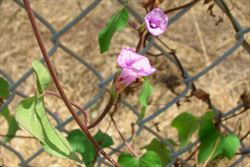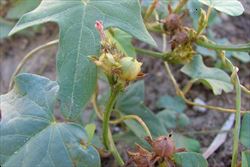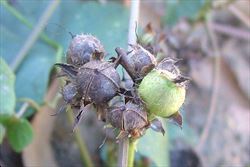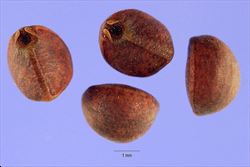Click on images to enlarge

habit (Photo: Sheldon Navie)

stems and leaves (Photo: Sheldon Navie)

close-up of three-lobed leaf (Photo: Sheldon Navie)

small tubular flowers (Photo: Forest and Kim Starr, USGS)

close-up of stem and flower from side-on (Photo: Sheldon Navie)

immature and mature fruit (Photo: Sheldon Navie)

close-up of fruit (Photo: Sheldon Navie)

close-up of seeds (Photo: Steve Hurst at USDA PLANTS Database)
Scientific Name
Ipomoea triloba L.
Family
Convolvulaceae
Common Names
Aiea morning glory, little bell, littlebell, pink convolvulus, pitted morning glory, potato vine, three-lobe morningglory, three-lobed morning-glory
Origin
This species probably originated in tropical America, but is now widespread throughout the tropics (i.e. pan-tropical).
Naturalised Distribution
Widely naturalised in northern and eastern Australia. Most common in the northern parts of the Northern Territory and in northern and central Queensland. Also present in the coastal districts of northern Western Australia, in south-eastern Queensland, and on Christmas Island.
Naturalised in south-eastern Asia (i.e. the Philippines, Cambodia, Indonesia, Thailand, Malaysia) and on several Pacific islands (i.e. Guam, Niue, Palau, Papua New Guinea and Hawaii).
Notes
Pink convolvulus (Ipomoea triloba) is regarded as an environmental weed in the Northern Territory and northern Queensland, and as an emerging or potential environmental weed in the northern parts of Western Australia. Because of its creeping and twining habit, it may overwhelm other vegetation in natural areas and is a potentially serious weed of the tropical regions of Australia. This species grows in various habitats from open, sunny hillsides to riparian areas and relatively dense forests.
Pink convolvulus (Ipomoea triloba) is listed as a medium priority pest species of aboriginal lands in the Northern Land Council area, and has also been recorded in Casuarina Coastal Reserve, in the Northern Territory. In Western Australia, it is currently restricted to the banks of billabongs and in floodplain vegetation at a few sites in the Kimberley region. However, it is a recent introduction to Western Australia and is thought to pose a significant threat to this area.

